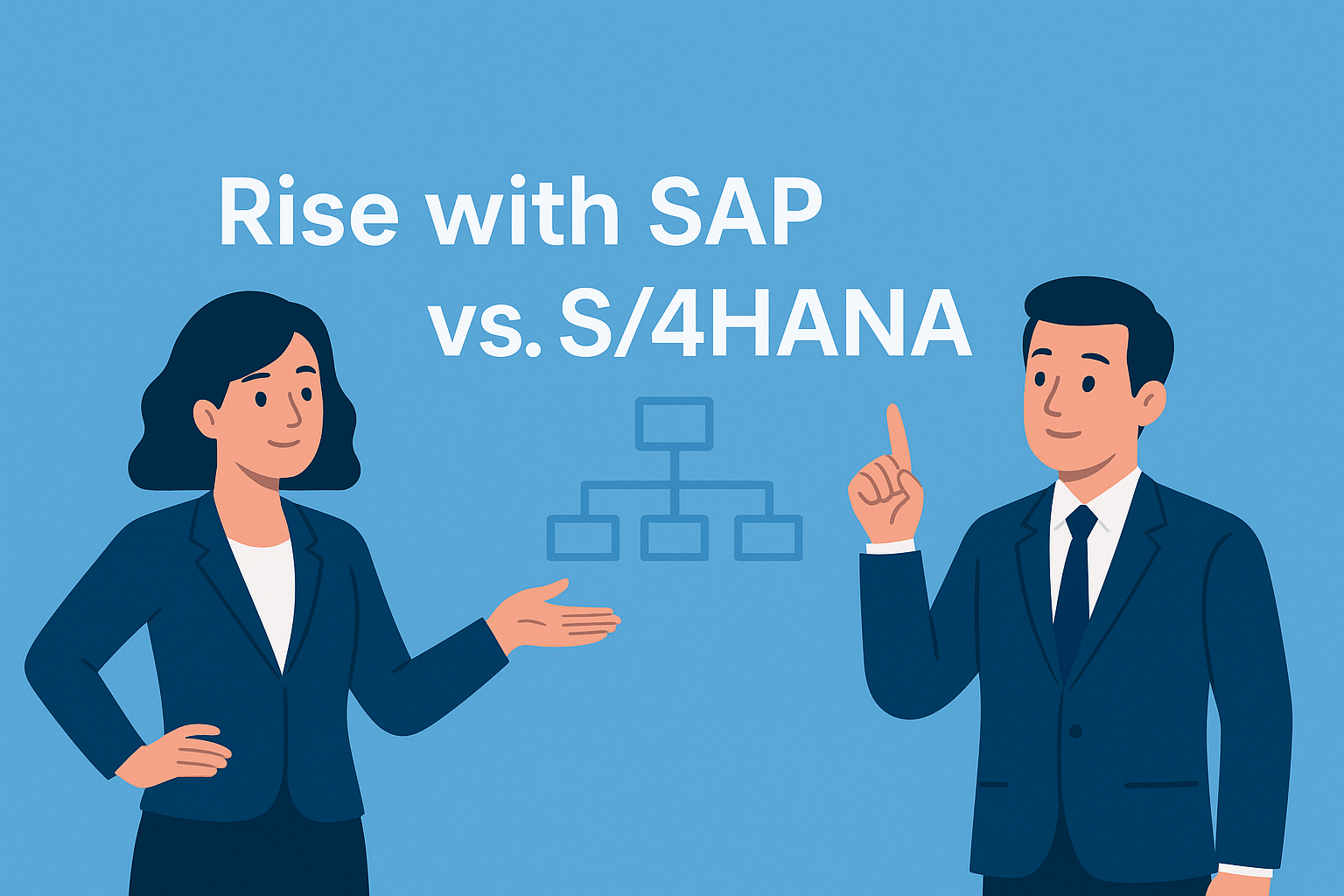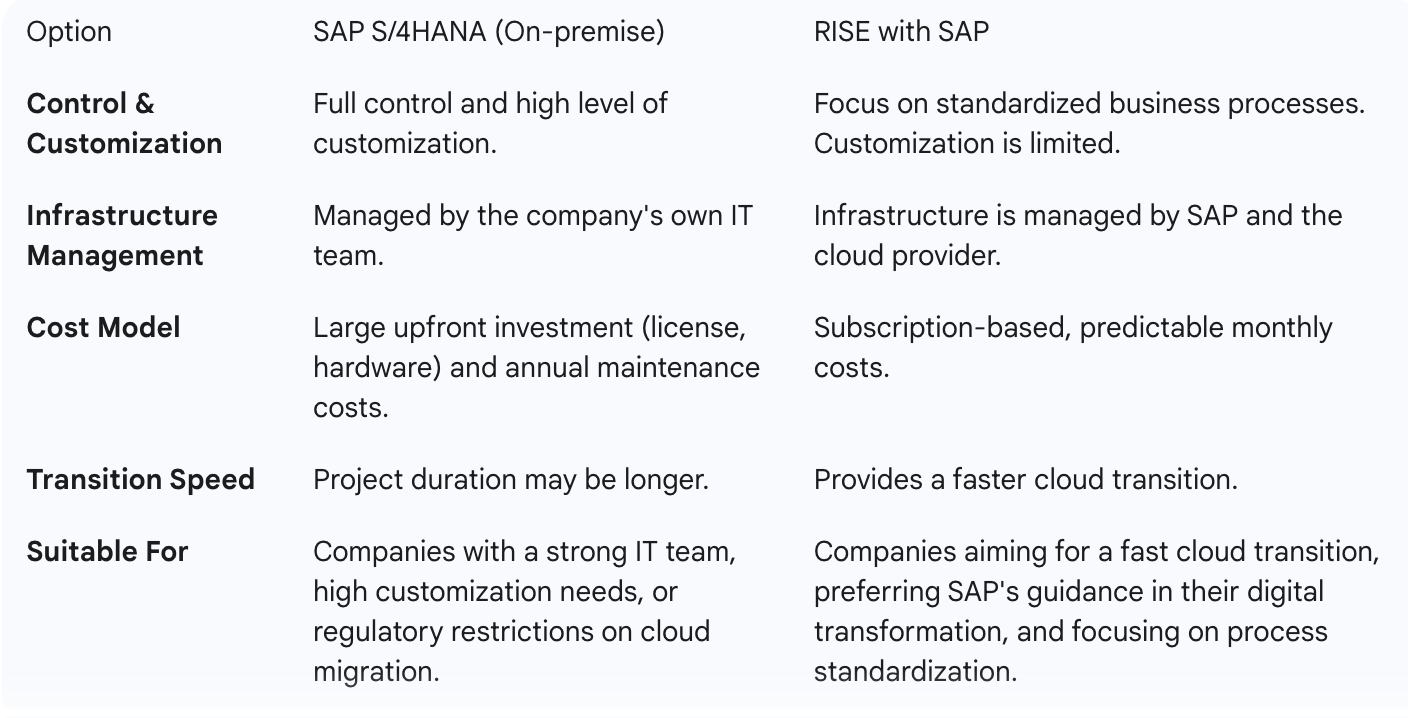Embarking on a company’s digital transformation is like setting a course across a vast ocean. Without the right vessel, the right crew, and the right compass, reaching the destination is nearly impossible. In this journey, SAP provides both the harbor where your ship is built and the map that guides your route. In recent years, however, two new signposts have appeared on this map: SAP S/4HANA and RISE with SAP. On one side, S/4HANA represents the voyage where you build and steer your own ship; on the other, RISE with SAP offers a turnkey package with a guided route. While often confused, one is the ship itself, and the other is the service model that defines the rules of the journey.
For those newly entering the SAP world, one of the most common sources of confusion is the distinction between “RISE with SAP” and “SAP S/4HANA.” Because the two terms are frequently used together, they are often mistakenly perceived as the same. In reality, one is a next-generation ERP software, while the other is a bundled service model designed to drive digital transformation. In this article, we will explore their history, key differences, and most importantly, which option companies should choose depending on their strategic needs.

What is SAP S/4HANA?
SAP S/4HANA is SAP’s next-generation Enterprise Resource Planning (ERP) software. Launched in 2015, it is fundamentally different from previous systems such as SAP ECC because it runs on SAP HANA, an in-memory database. Thanks to this technology:
- Data can be processed much faster
- Real-time reporting becomes possible
- Complex analytics on large datasets are simplified
S/4HANA is available in both on-premise (installed in the company’s own data center) and cloud deployment models. Companies can either purchase the system and manage it with their own IT teams, or consume it as a service through cloud providers.
Here, the role of the SAP Basis team is mission-critical. From ensuring system stability to managing updates, backups, performance optimization, and security configurations, all these tasks fall under SAP Basis expertise. Without strong Basis management, it is nearly impossible to unlock the full potential of S/4HANA.
What is RISE with SAP?
In 2021, SAP introduced RISE with SAP as a “Business Transformation as a Service” model. Unlike a standalone software, RISE with SAP is a comprehensive subscription package designed to accelerate a company’s journey to the cloud.
The package brings together all the key components of digital transformation under a single contract:
SAP S/4HANA Cloud, Private Edition: The ERP software at the core of the package. As a single-tenant environment, it provides flexibility and control close to on-premise setups.
Infrastructure: Customers can choose where the system runs (Google Cloud, Microsoft Azure, AWS, etc.), while SAP takes full responsibility for managing it.
Business Process Transformation Tools: Built-in tools to analyze and improve business processes.
SAP Business Network: Access to a global business network that simplifies collaboration with partners.
Technical Services (BTP Credits): SAP Business Technology Platform (BTP) credits included for migration, extensions, and customizations.
The purpose of RISE with SAP is to simplify complex cloud transitions. By managing everything through a single point of contact (SAP), companies reduce operational overhead and accelerate their digital transformation journey.
However, while SAP owns the responsibility of managing the infrastructure, the need for SAP Basis expertise remains essential at the application layer. In fact, the role of Basis evolves into a more consultative model—focusing on monitoring SAP-delivered services, optimizing application architecture, and strategically aligning business processes with technology.
Key Differences Between RISE with SAP and S/4HANA
Feature | SAP S/4HANA | RISE with SAP |
Definition | Next-generation ERP software | Package including ERP + infrastructure + transformation tools + business network |
Scope | ERP system only | Digital transformation package |
Deployment Model | On-premise or cloud | Cloud only, subscription-based |
Infrastructure | Company servers or preferred cloud provider | SAP’s selected cloud providers |
Licensing | License + maintenance (on-premise) or cloud subscription | Software + services + infrastructure under a single contract |
Focus | ERP implementation and management | Business transformation and cloud adoption |
Target Audience | Companies managing and customizing their own ERP | Companies seeking a fast and standardized move to the cloud |
History: From S/4HANA to RISE with SAP
2015 – The Birth of S/4HANA: Leveraging the power of the HANA in-memory database, SAP introduced S/4HANA as a faster, more analytics-driven ERP system compared to its predecessor, ECC. At this stage, most migrations were planned as on-premise projects, often lengthy and resource-intensive.
2015 – 2020: Migration Challenges: While companies recognized the benefits of S/4HANA, many were discouraged by high licensing and infrastructure costs, the technical complexity of migration, and the long project timelines required for implementation.
2021 – A New Approach with RISE with SAP: To address these challenges and encourage cloud adoption, SAP launched RISE with SAP. This model transformed cloud migration into a turnkey service package. With it, SAP shifted from being “just a software vendor” to becoming a strategic partner in customers’ digital transformation journeys.
SAP’s Recommendation: The Future Is in the Cloud
SAP has made its strategic direction clear: the future lies in the cloud. RISE with SAP is the clearest expression of this vision. For companies that are new to ERP or planning their first move to the cloud, SAP strongly recommends adopting the RISE with SAP model.
That said, SAP continues to support on-premise and hybrid deployments of S/4HANA to provide flexibility. This is especially critical for companies that:
- Must run their ERP in their own data centers,
- Face regulatory restrictions that prevent cloud adoption, or
- Require heavy customizations that are not feasible in a standardized cloud environment.
In these cases, S/4HANA on-premise remains a strong option, giving businesses control over infrastructure while still leveraging the power of the HANA database.

Further Reading
With RISE with SAP, the way systems are built, managed, and create value is being redefined from the ground up.
Yet BASIS consultants remain the technical backbone of this transformation — discover how!

When Should You Choose S/4HANA (On-Premise)?
- If your company wants to manage its ERP system in its own data center
- If security, regulatory requirements, or special integrations prevent a move to the cloud
- If you need full control and deep customization of your ERP system
- If you have a strong IT team capable of managing infrastructure, or a trusted partner to provide this service
In the on-premise model, SAP Basis expertise forms the backbone of infrastructure management. Critical responsibilities such as efficient use of hardware resources, continuous performance monitoring, backups, security patching, and system updates are all handled by the Basis team. Without strong Basis management, it is impossible to leverage the full potential of an on-premise ERP system in a secure and sustainable way.
When Should You Choose RISE with SAP?
- If your company aims for a fast transition to the cloud
- If you want software + services + infrastructure under a single contract
- If you prefer to rely on SAP’s guidance in your digital transformation journey
- If you prioritize standardization and speed in business processes
- If your IT team wants to focus on business value rather than infrastructure management
Although infrastructure is managed by SAP under the RISE with SAP model, SAP Basis consultancy remains critical at the application level. Tasks such as system optimization, user management, security, and integrations require professional Basis expertise to ensure a smooth cloud journey. This support can be provided by an in-house team or an external consulting partner (SAP Partner).
Comparison table for decision-making

The Decision Point: Critical Questions for IT Leaders
As an IT leader, asking yourself the right questions will guide you toward the right choice:
- Total Cost of Ownership (TCO): Have you compared the upfront investment and ongoing maintenance costs of an on-premise system with the subscription model of RISE with SAP? Which approach proves more cost-effective in the long run?
- People and Skills: Does your organization have a strong SAP Basis team capable of managing its own IT infrastructure? Or would it be more practical and cost-efficient to shift this responsibility to SAP (via RISE) or to a trusted service provider (partner)?
- The Future of Work: Does your company’s growth strategy and vision support a cloud-first model, or is a hybrid approach more suitable?
- Security and Compliance: Do industry regulations (e.g., finance, healthcare) allow you to store data in the cloud? Where must your data physically reside to comply with sovereignty requirements?
The most important point to remember: no matter which path you choose, your journey cannot succeed without robust SAP Basis management. In an on-premise model, Basis teams handle all infrastructure responsibilities. With RISE, their role shifts toward application-layer optimization, security, and integrations — evolving into a critical advisory function.
Conclusion: The Right Path Is the One That Fits You
SAP S/4HANA and RISE with SAP are not rivals but complementary approaches. S/4HANA is a product, while RISE with SAP is a comprehensive service model that includes this product.
- S/4HANA on-premise is ideal for organizations with strong IT teams, high customization needs, and a desire to control their own infrastructure.
- RISE with SAP is the better fit for companies looking to move quickly to the cloud, embrace digital transformation under SAP’s guidance, and standardize their business processes.
Whichever model you choose, SAP Basis expertise — whether in-house or from a trusted partner — remains the beating heart of your ERP system. Business continuity, security, performance, and user experience all depend directly on strong Basis management.
While SAP’s long-term vision is firmly cloud-oriented, the final decision must align with your organization’s strategy, needs, and available resources. For IT leaders, the task is to weigh the pros and cons of both models carefully — and select the path that ensures the most value for the business.

